As tradition dictates, the new season in fashion began in New York, and the Spring/Summer 2026 shows have kicked off fashion month with a surprisingly crowded schedule. There are ample slots for the city’s young designers - think Collina Strada, Gabe Gordon and Lii - along with the American stalwarts who reliably carry the flag abroad: Ralph Lauren, Michael Kors, Tory Burch, and Coach to name the most obvious.
The first toast, naturally, came not on the runway but at the dinner table. Veuve Clicquot and Jacquemus set up camp at The Boathouse in Central Park - eagle-eyed Sex and the City devotees will recall the spot from Carrie and Big’s pond-side plunge - where Julia Roberts, Emma Roberts, and Solange Knowles turned up to raise a glass. It was a starry overture that signalled this season’s emphasis on spectacle.
Then the week truly began with Ralph Lauren. At 85, the godfather of American fashion remains unchallenged in his ability to stage a show that feels like an act of national theatre. Off-schedule but commanding all the attention, his return was the prelude to several days of ‘best in show’ moments. That same day, Rachel Scott made her soft debut at Proenza Schouler, bringing her Diotima-honed sensibility to the house in a collaborative collection that whispered of new beginnings.
Michael Kors followed, having shifted from his usual closing Tuesday slot to Thursday morning, and when Valentino Beauty resurrected Studio 54 for one night only, the guest list featured a headliner to end all headliners: Cher. Because if New York does anything well, it is the art of reminding the world that fashion here is about more than clothes - it’s about moments that live forever
By the weekend, the baton was passed to Calvin Klein Collection. Veronica Leoni’s sophomore collection was arguably one of the most anticipated of the season, following her razor-sharp February debut that recalibrated American minimalism for a new generation. If her front row was buzzy then, it was a frenzy now, featuring Lily Collins, Naomi Watts and Rosalia. Meanwhile, Area, under the new creative direction of Central Saint Martins alumnus Nicholas Aburn, drew in the masses - everyone excited to see the new creative direction for the brand.
Here, Grazia’s senior fashion news and features editor, Henrik Lischke, reports all the highlights of New York Fashion Week S/S ‘26.
Tory Burch
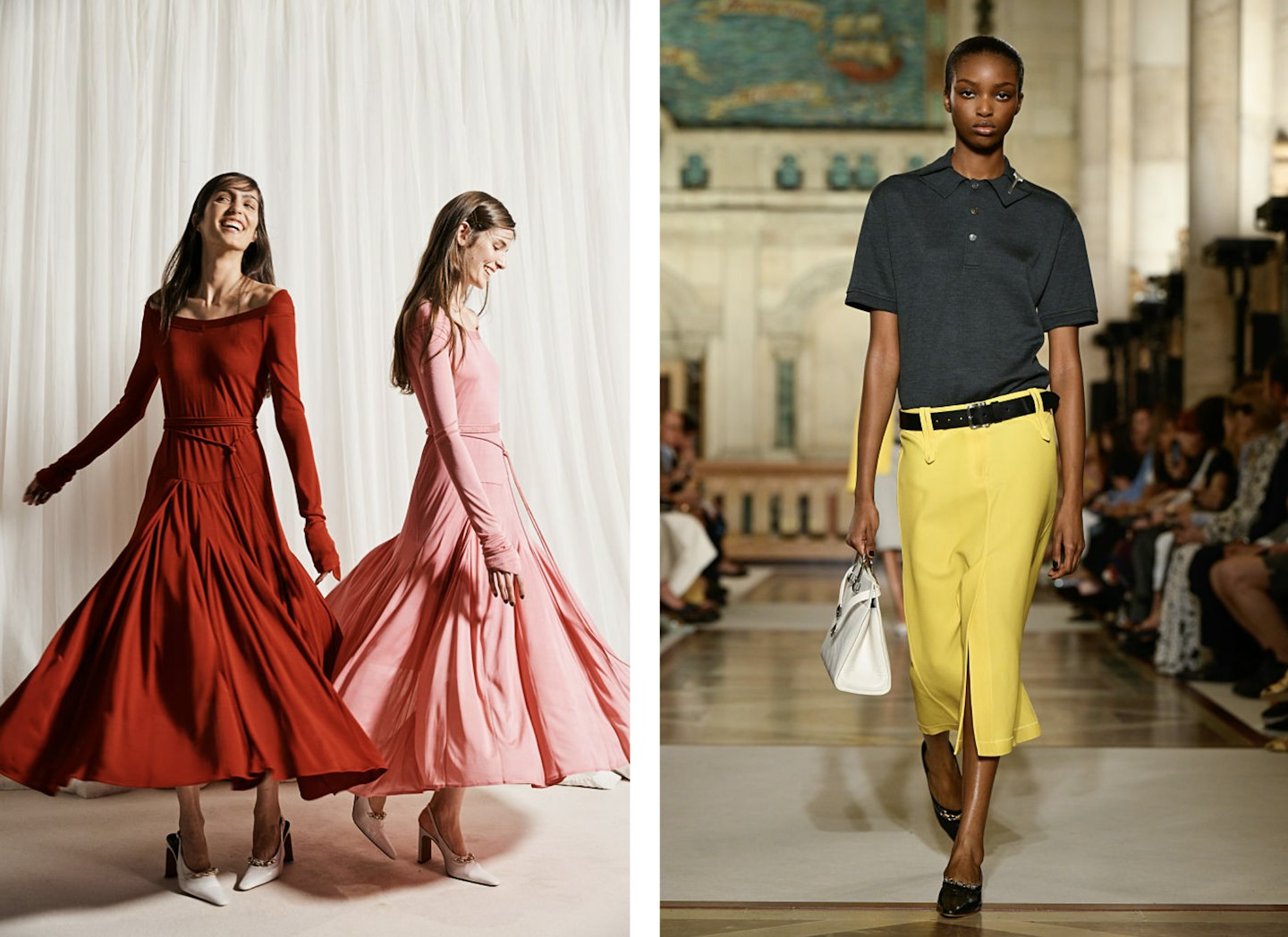
‘I always want to be a problem solver, so women don’t have to figure it out,’ Tory Burch said backstage after her Spring/Summer ’26 runway show on the penultimate day of New York Fashion Week. For the occasion, she swapped uptown ballrooms for Brooklyn’s Williamsburg Savings Bank Tower, its domed ceilings and marble grandeur underscoring her mission to elevate American sportswear into something both useful and aspirational. Emma Roberts, Naomi Watts, and Tessa Thompson looked on from the front row as Burch unveiled her most assured outing yet.
Her dialogue with women - ‘learning as we go on about what they’re craving and what they want’ - surfaced in clothes that balanced ease with polish. Colour was her entry point. ‘I wanted it to be about colour in an eccentric way,’ she explained, and it appeared in a flowing viscose jersey dress in pink, a low-slung canvas skirt in yellow, and a cropped trench in jolting cyan. Silhouettes lingered low on the hip, segueing into 1920s-style beaded dresses that glinted with restraint.
Accessories, however, carried the punch. ‘I love jewellery and I took the more is more approach,’ Burch admitted, layering pearls, glass flowers, and seed beads into sets that matched wraparound sunglasses and shell-punctuated jackets. Footwear shifted away from the once-ubiquitous Reva flats toward ’50s-style pumps and barbed-wire-trim sandals. Bags included Radziwills adorned with heavy hardware and Romy buckets reimagined in distressed leather.
The collection was also anchored by personal memories. A reworked pinstripe suit nodded to her father, while her mother embraced her first backstage. It was an intimate gesture within a broader statement: Burch is reshaping American sportswear with instinct, precision, and clothes women genuinely want to wear.
Diotima
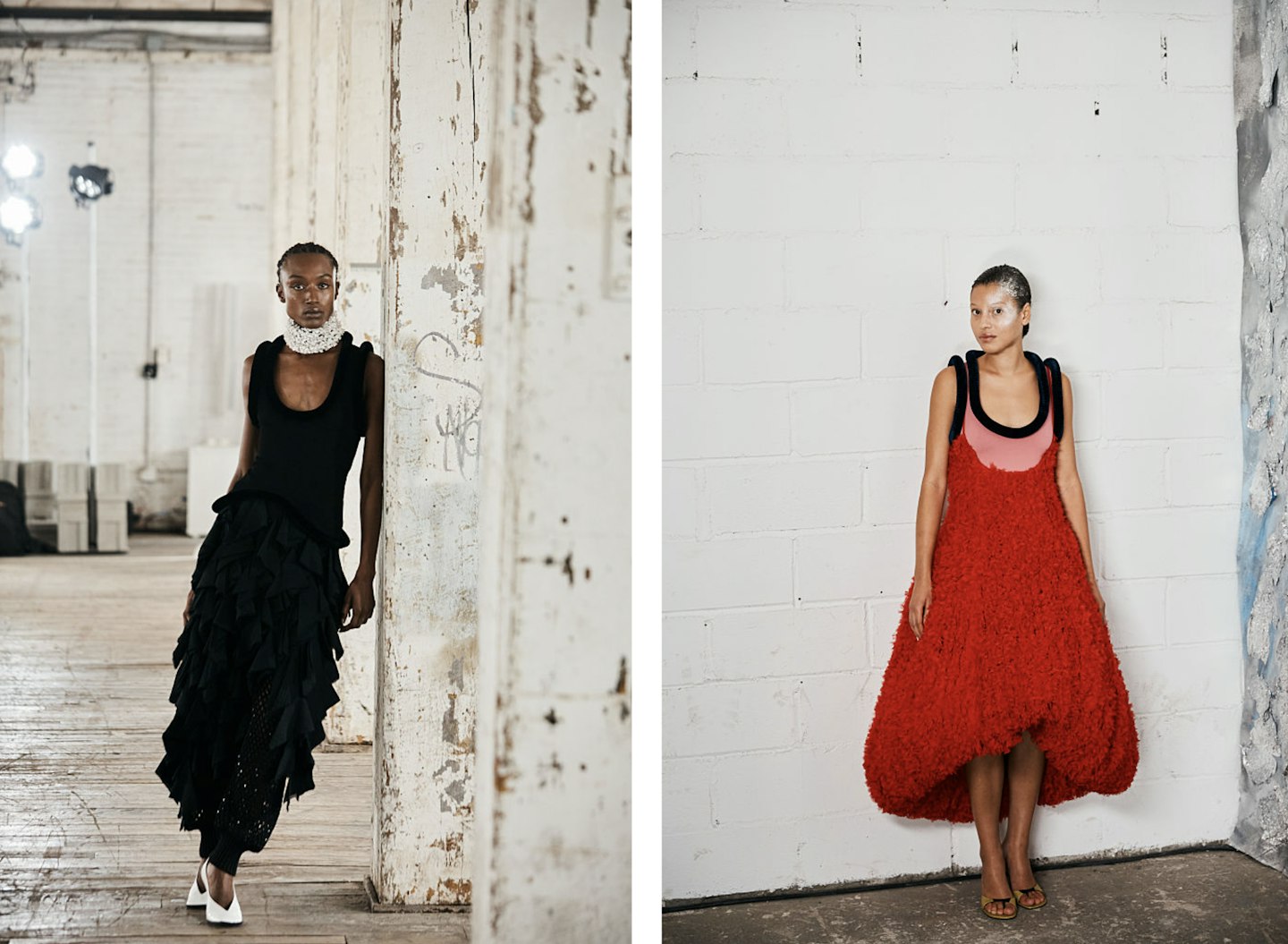
Rachel Scott has had a week like no other. She unveiled her first collection alongside Proenza Schouler’s design studio, having been named the American label’s creative director earlier this summer. She collected yet another CFDA nomination for American Womenswear Designer of the Year (the award she won last year). And then there was the runway debut for her own brand, Diotima. Until now, Scott had opted for the intimacy of presentations but Spring/Summer 2026 marked her first time on the catwalk. The benches were heaving, and the pre-show whisper was unanimous: this was the ticket to secure. The anticipation wasn’t misplaced. What followed was Scott at her most unfiltered - her most exacting - offering a collection that paid tribute to meticulous craft and her Jamaican heritage.
‘It is a super emotional collection,’ she explained post-show. ‘Last season I was really angry with everything - the state of America and the world we’re living in, and I’m still extremely angry. But I think that the manifestation of this anger is different this time, it’s coming through in a much more rebellious way.’ That rebellion found its roots in Carnival, both in the Caribbean and across the diaspora. She looked to Peter Minshall’s sketches of Carnival characters to build her line-up. ‘Carnival is this moment of resistance against repression, but it’s also one that is very subversive, that’s very exuberant, and it’s grounded in sensuality. There are characters in Carnival that are poking fun at the colonisers, which I think is really interesting. I didn’t want to replicate them, but I wanted to suggest them.’
That suggestion came alive in paillette-trimmed duster coats, caged bras, and macramé-shredded skirts. In sharp waistcoats and ‘décolleté frames’, as per the show notes. Her signature crystal mesh knits appeared anew as bodysuits and other silhouettes, fabric manipulation rendered garments in featherweight textures, while jolts of lime, magenta, and fuchsia injected even more rhythm. It was a proposition met with rapturous applause, and one that underlined Diotima’s singular place in New York’s fashion ecosystem.
With her hands now on the wheel at Proenza Schouler, was this a one-off? Scott’s assurance was clear: it was not. Whatever she turns to next, there’s no doubt she’ll do it with the same refusal to compromise.
Because when Rachel Scott shows us anger, joy, rebellion, and sensuality stitched into the same garment, we’re reminded that fashion isn’t just what we wear - it’s what we resist, what we remember, and what we become.
Coach
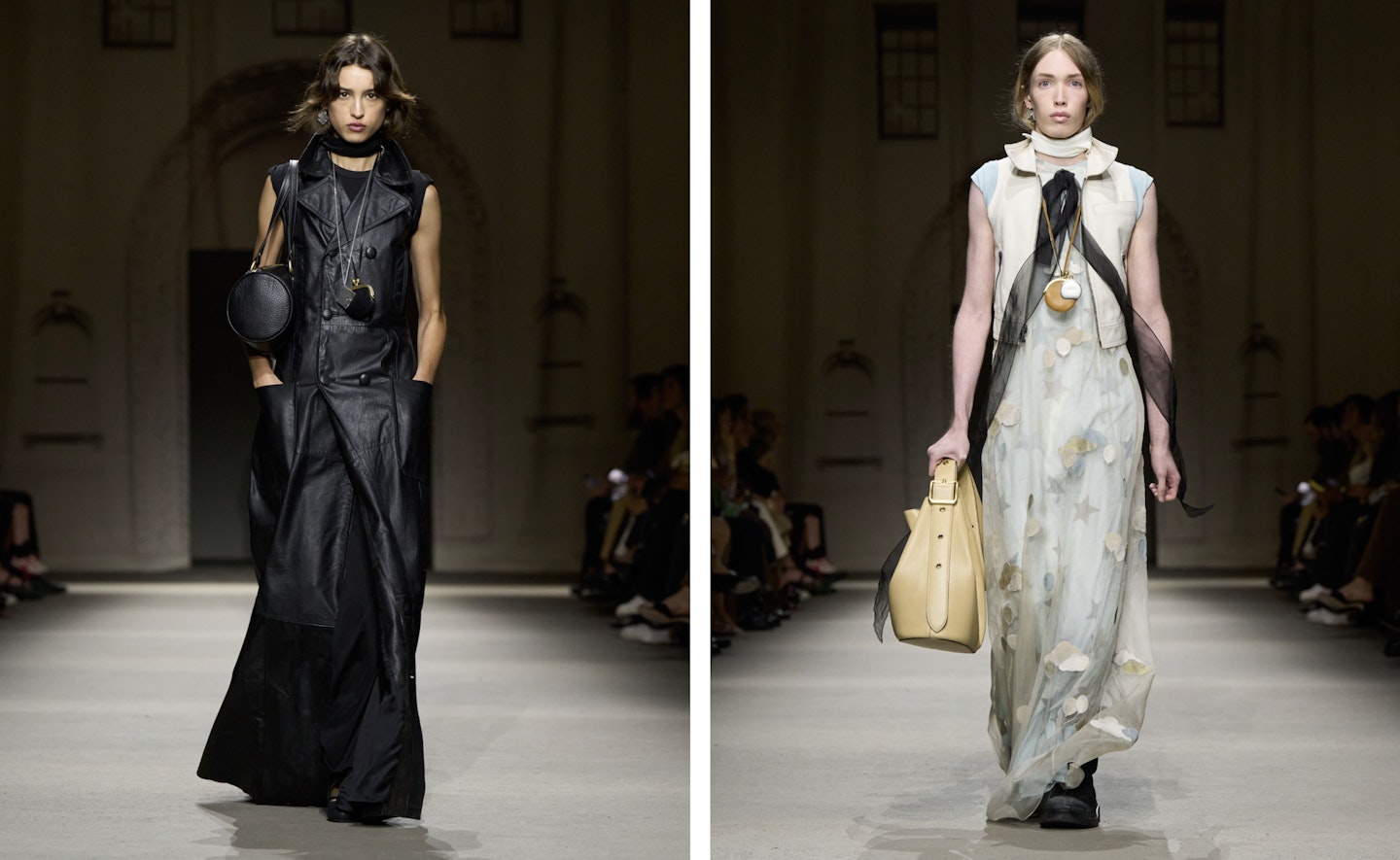
New York may be Stuart Vevers’s adopted home, but he continues to tell its story better than most. Since taking the reins at Coach in 2013, he has turned the heritage label into a vessel for nostalgia and reinvention, with a sharp eye on Gen Z’s appetite for storytelling. His Spring/Summer ’26 collection was no exception - an ode to the fragments that make up city life, shown through 47 looks that blurred romance and pragmatism.
‘The starting point was a crisp New York morning, a new day, welcoming something new,’ Vevers said backstage. But equally, the inspiration came from the city’s keepsakes: ‘a playing card or sequin in a gutter, a random sticker on a lamppost,’ the overlooked tokens that carry memory. Vevers explained further: ‘It was quite romantic. I don’t think things have to be new and perfect to be desirable. It’s about playing with those old materials or giving that effect.’ That sensibility informed upcycled workwear pants - ‘because people actually worked in them’ - and other pieces treated to mimic the patina of time.
The clothes captured this tenderness with grit. A sleeveless coat in repurposed leather was paired with lace-up flats, sheer top-layer dresses, appliquéd with doodle-like motifs, floated over jersey underpinnings with rolled-up T-shirt sleeves. A graphic T-shirt dress, printed like a postcard, was grounded by heavy work boots. The nostalgia extended into accessories: the Kisslock bag, Vevers’s oversized coin purse, proliferated in every size - dangling as keyrings, clutched as minis, or blown up as leather carryalls.
By the finale, Vevers had managed what few can: to capture both his audience’s attention and the essence of a city. Even if you’ve never set foot in New York, you’d get the story.
Toteme
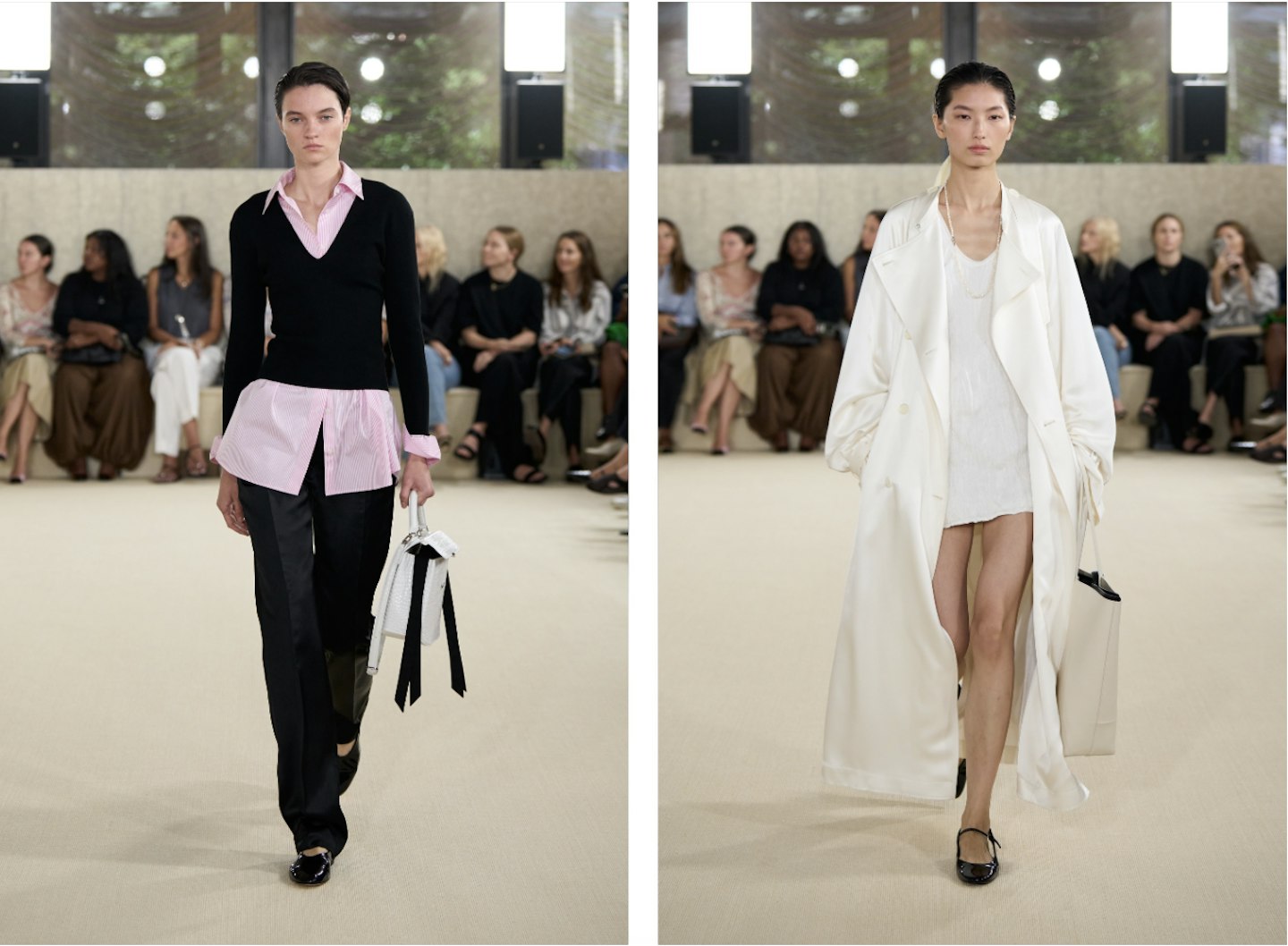
Toteme’s Spring-Summer ’26 show slotted neatly into a season obsessed with unravelling - of seams, structures, old belief systems and the old rules of dressing. On the New York schedule, the Stockholm brand brought its signature ease into sharper focus, peeling back polish to reveal a wardrobe at once undone yet elevated. Elin Kling and Karl Lindman leaned into deconstruction, showing garments with raw edges and time-worn finishes that felt like an homage to heritage while quietly dismantling it.
The clothes were tactile and lived-in: crinkled cotton tops, aged linens, and supple leathers delivered that worn-in beauty the brand does so well. A crisp cotton shirt, layered under a shrunken jumper, created an effortless throw-on-and-go silhouette. Slips peeked out from beneath knit dresses, while opera coats and voluminous but cropped trench coats - with frilled sleeves poking out - gave proportion play a subtle drama. Fluid trenches skimmed over cotton minis, embroidered shawls and lace throws added a more bohemian edge than Toteme usually entertains, expanding its vocabulary without losing control.
Accessories punctuated the looseness. Towels slung over tote bags felt knowingly irreverent, while boxy leather carryalls felt like familiar territory. Shoes - peep-toe styles that revealed all toes, shoots and streamlined low-profile flats - added a high-shine polish against the matte textures of knits and cottons. The palette stayed faithful to Toteme’s restrained codes - black, optic white - interspersed with washed pinks and deep green.
The result was a collection that teased apart the brand’s archetypes - the tank, the trench, the pajama set - then rebuilt them with a liberating hand. Undone, yes, but never unconsidered.
COS
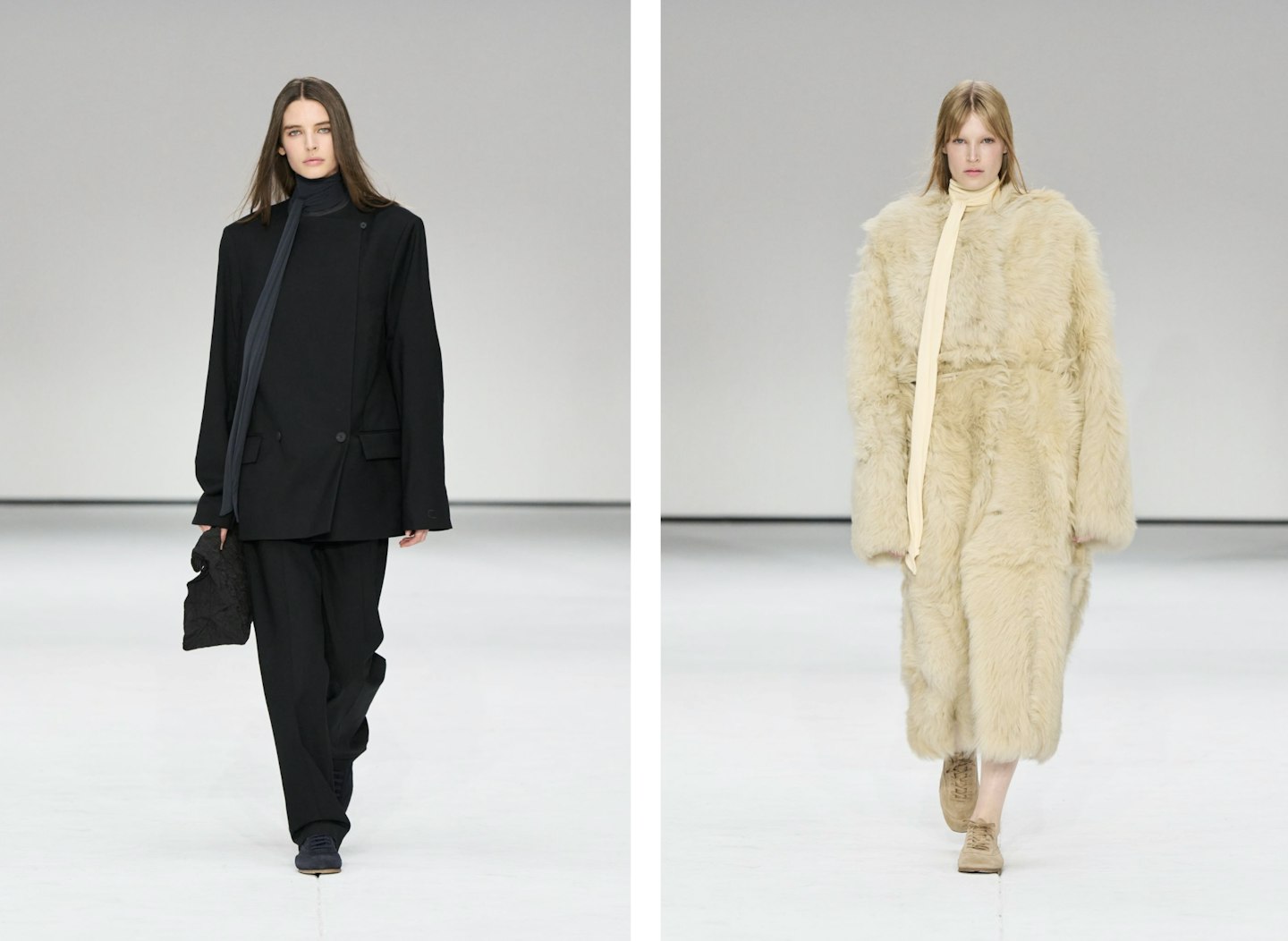
COS is no longer your average high-street pit stop, and Karin Gustafsson is the reason why. Under her hand, the H&M offshoot has transformed into shorthand for polished, design-driven dressing. That shift was on full display at New York Fashion Week, where Gustafsson staged her fourth COS runway outing inside Brooklyn’s Greenpoint Terminal Warehouse. The raw industrial space, reimagined in pristine white and punctuated with shifting light boxes, was the perfect foil for the brand’s Autumn/Winter ’25 collection: serious, sculptural, and perfectly shoppable.
An amalgamation that Gustafsson has invested in with a huge return on investment: COS has become one of the hottest brands globally, according to search engine Lyst’s reports. When the rest of the world is falling out of love with luxury, the brand is a good place to be in, as its tackling luxury from the high street up, offering the masses carefully designed pieces, that, yes, can come with an unexpectedly lofty price tag these days (leather is high up in the hundreds and shearling over a £1k), but it’s a concept that works, and one that draws in big crowds
The palette for the collection on show stayed deep - inky navy, steel grey, jet black - with flashes of neutral grounding. Materials carried the weight: pony-skin textures, buttery leather, shearling, and wool lent a heft and richness far removed from the high street’s usual remit. For womenswear, Gustafsson cut cocooning volumes into enveloping scarves and high-necked shapes, but also injected delicacy with sheer dresses that revealed the body in motion. What’s more, shearling coats that are surefire sell-outs already.
If Gustafsson has proved anything, it’s that COS is no longer just outfitting the fashion faithful - it’s positioning itself as the everywoman’s (and everyman’s) answer to accessible luxury.
Khaite
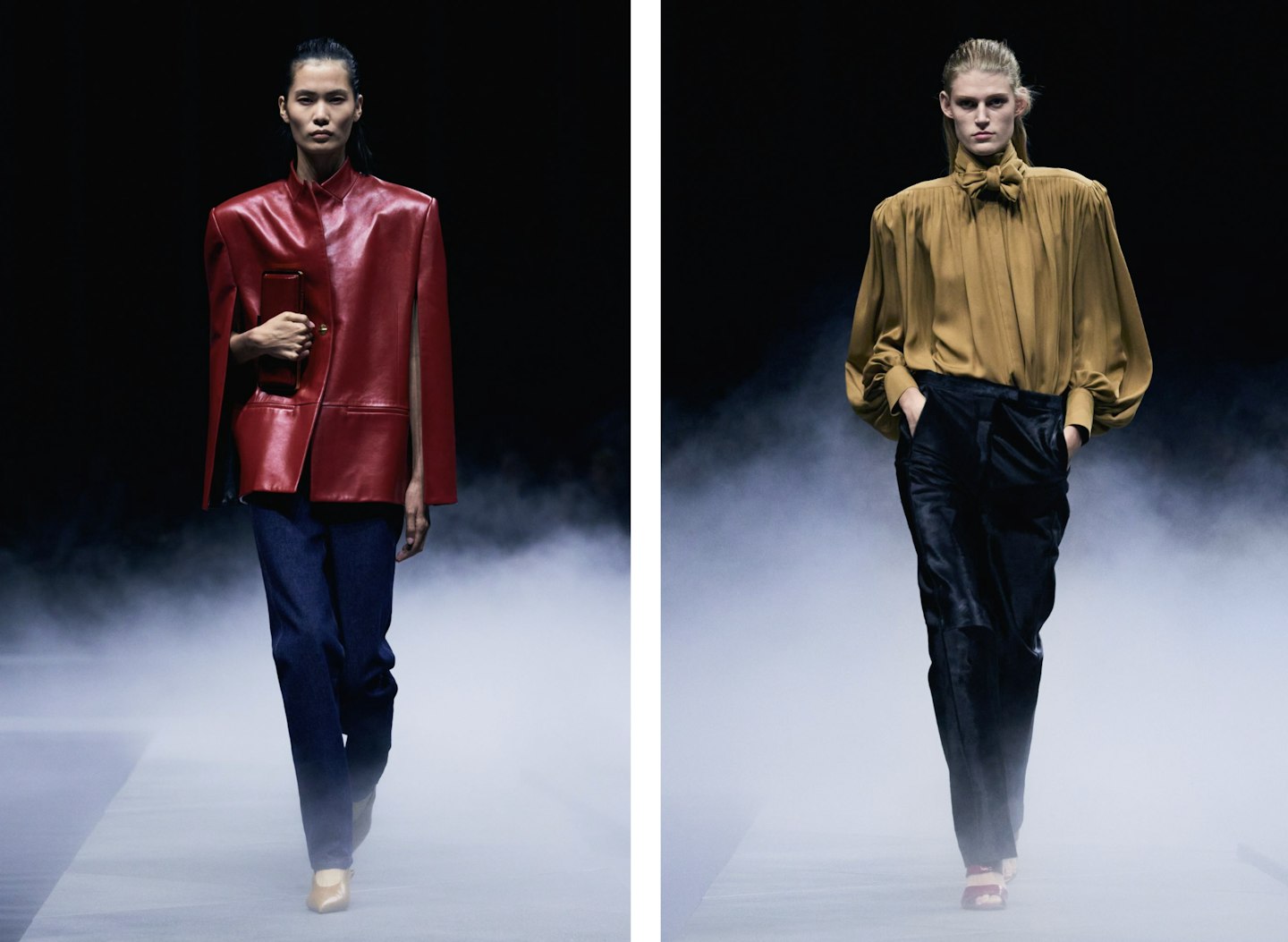
Catherine Holstein’s Khaite has long outgrown its Katie-Holmes-in-a-cardigan reputation, and Spring/Summer ’26 hammered home just how ambitious her vision has become. The West Village venue, transformed into an on-water installation of concrete rocks by her architect husband Griffin Frazen, set the stage for a collection that was equal parts punk-rock ferocity and New York polish. Front row luminaries - from Rosie Huntington-Whiteley to Calvin Klein’s creative director Veronica Leoni - jostled for space, while Kendall Jenner, a loyal Khaite acolyte, closed the show, ensuring hype levels soared. Not that Holstein needs that - the women of New York (brokers, fashion editors and entrepreneurs alike) have unanimously and unequivocally subscribed to Khaite as the go-to brand.
On the runway, she laid out a wardrobe arsenal for exactly those women: wrap-over leather blazers reframed everyday tailoring into architectural feats. Strapless gowns, cut from sober suiting fabric but frilled with organza, pushed the boundaries of eveningwear. Heeled moccasins - a Frankensteinian invention in less deft hands - seemed destined for it-girl ubiquity. Elsewhere, polka-dotted silks with linebacker shoulders, floral embroideries with a mischievous wink, and boom-boom minis in true ’80s bravado underscored Holstein’s talent for fusing toughness with temptation. All to the thumping soundtrack of Blur and Pulp (and Chopin).
Leather - sumptuous, uncompromising - ran through like a lifeline, anchoring the more playful flourishes. Accessories, too, demanded instant gratification: bags and heels so sharp, waiting a season to buy them feels impossible. By the finale, it was clear: the Khaite woman is no longer just chic, she’s untouchable. What's more, Holstein reminded us that New York’s reigning queen of cool doesn’t need reinvention, only amplification.
Eckhaus Latta
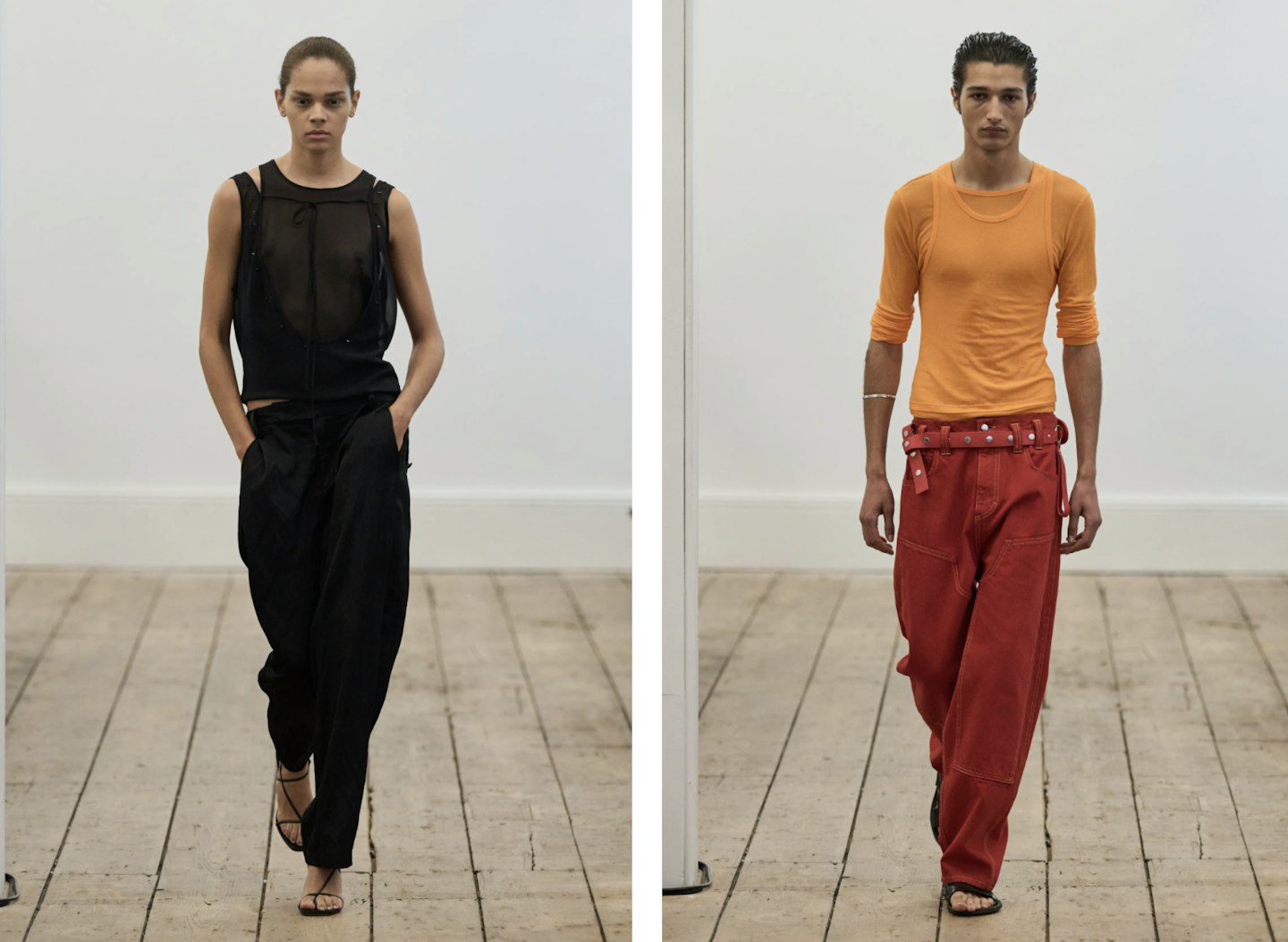
Mike Eckhaus and Zoe Latta have long thrived on their cultish downtown following, but Spring/Summer ’26 proved that self-awareness can be a brand’s greatest strength. The show opened with nine stark, all-black looks - a finely tailored manifesto in slick jackets, strappy dresses, and trousers that clung in all the right places. It was a bold reminder that Eckhaus Latta, often known for raw edges and slouch, can also flirt with precision.
Then came the hits for their disciples: carpenter jeans; sheer knits stretched taut across torsos; layered tees sliced with square cut-outs for the fearless; tulle trousers; studded belts; belly bags slung low on hips. It all felt retail-ready without losing that signature irreverence. Sunset shades of tangerine, red, and yellow punctured the monochrome palette towards the finale, injecting a jolt of summer optimism before the show drew to an abrupt stop.
But no Eckhaus Latta presentation is complete without its knowing wink. This season, it came via a model sparking up mid-walk, and the whoops from longtime fans pressed against the venue’s walls. The result? A collection that was pared-back yet playful, elevated but unpolished, exactly what their audience came for. In a season of big-name debuts, Eckhaus and Latta proved that staying true to yourself can be just as thrilling.
Willy Chavarria
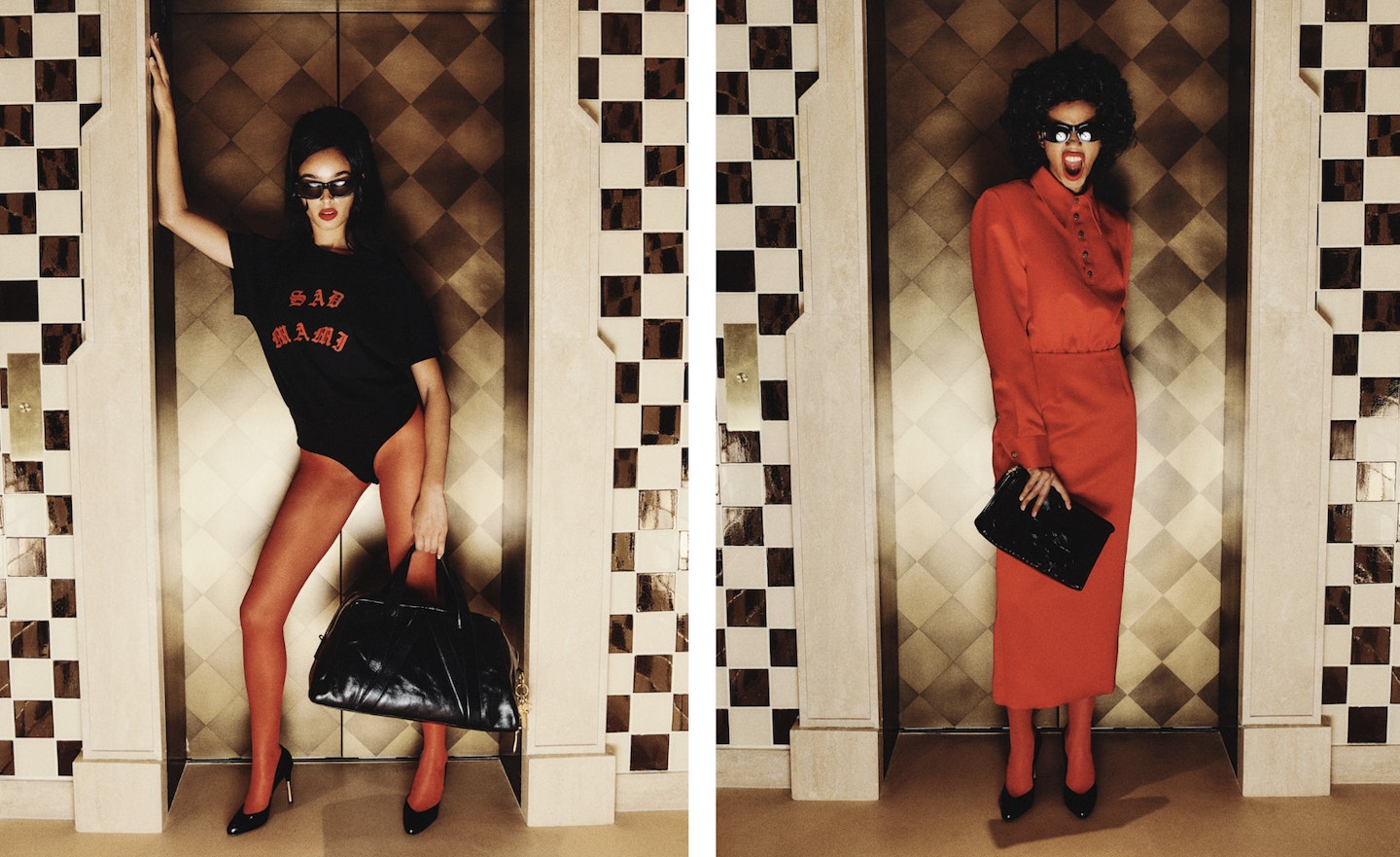
Willy Chavarria has been conquering Paris of late, but for Spring/Summer ’26 he brought the celebration back to New York, staging an intimate, old-school salon-style show at Printemps to mark the official launch of his womenswear in the department store. Models weaved through the crowd clutching numbered placards, a nod to retail theatrics, though no one present needed persuading to buy into Chavarria’s vision. Many of the looks had debuted at men’s week in Paris earlier this summer, but here, on home turf, they carried a fresh charge.
Chavarria’s design DNA was present in full force: a fusion of Chicano heritage, Catholic iconography, and a flair for exaggerated proportions reimagined with a razor-sharp elegance. Satin and leather column gowns clung with deliberate severity, offset by sweeping trench coats and oversized tailoring that retained his signature bravado. Pencil skirts and shirtdresses, neatly cinched, offered structure, while slick leather trenches and oversized shirting played to his knack for power dressing with a sultry edge. Vertiginous pumps sharpened silhouettes, underscoring a new sensuality in his womenswear proposition.
True to form, Chavarria injected irreverence too: a bodysuit stamped with ‘Bad Mama’ strutted past the rows of editors. It was a reminder that behind the sculptural tailoring and ecclesiastical grandeur lies a designer who never forgets the fun. Homegrown and now globally recognised, Chavarria proved that whether in Paris or New York, his shows still spark the kind of electricity the city has been craving.
Calvin Klein Collection
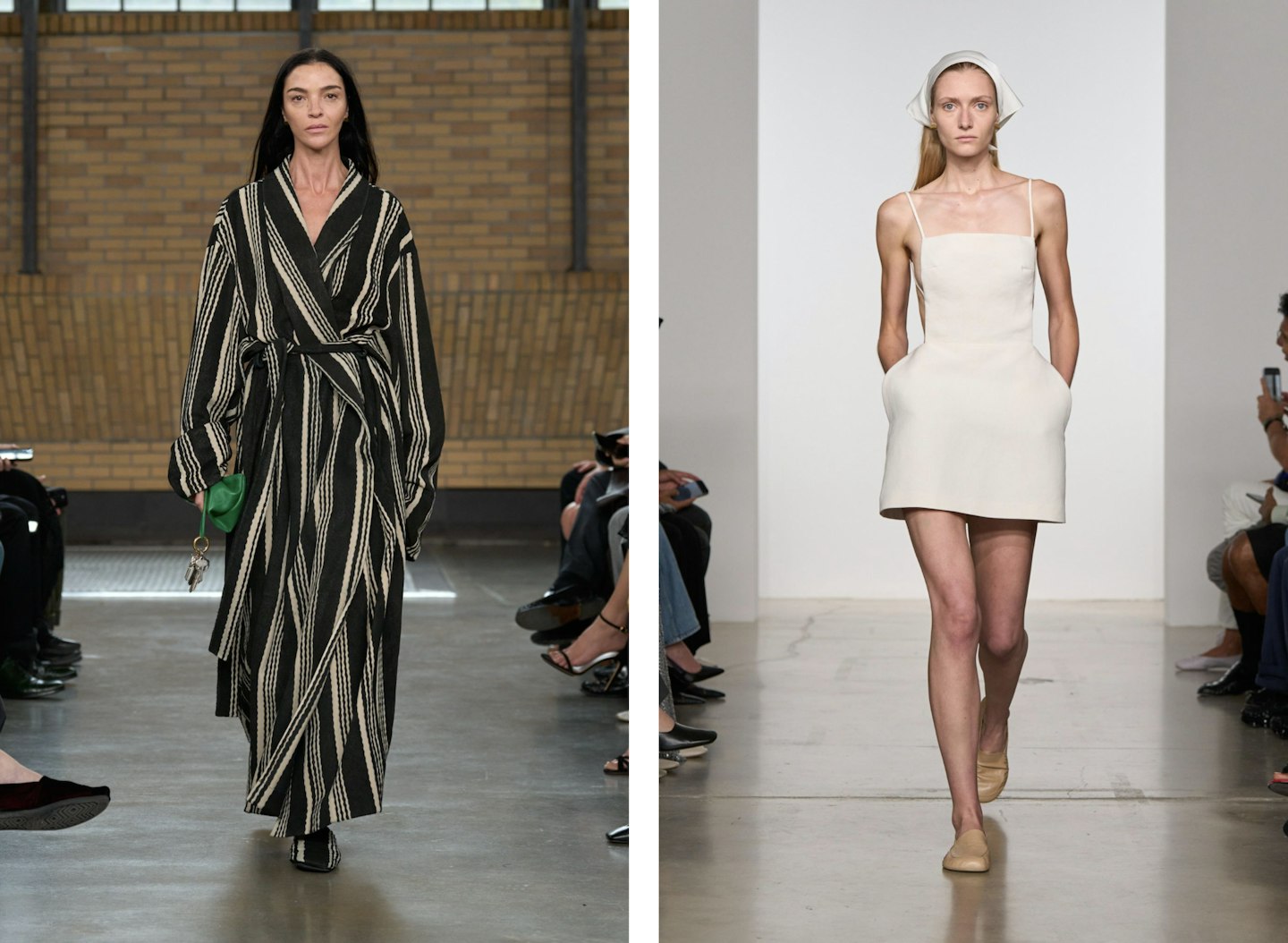
Veronica Leoni’s second collection for Calvin Klein carried the weight of expectation. This is a brand known for its era-defining characteristics - reinterpreted for a new generation as quiet luxury - but the sophomore outing suggested Leoni is pushing towards something more intricate. Even if the show notes declared the word ‘unadorned’, the runway told a slightly different story. ‘I’m a big fashion nerd,’ the designer admitted afterwards. ‘I feel the most joy when I’m making clothes. And there’s a very big dose of design that went into this collection.’
What unfolded was an homage to the beauty of the normal: the everyday people Leoni watches on her jetlagged dawn walks through New York - the joggers pounding the pavement, the night owls drifting home in last night’s clothes. ‘When I come here I walk a lot and the city is always full of people going for a run or coming from the night before - and they all have a pragmatic approach to the outfit.’ That pragmatism surfaced in the details: minimal accessories strung with bunches of keys, elastic goggles, bras peeking from under tops.
‘I discovered that Calvin Klein belongs more to the people than it belongs to me, so I tried to get close to the DNA of the brand and the fetishes of it, and to really own it,’ Leoni continued. Jersey was manipulated into Dynasty-inspired gowns, CK underwear elastics woven into a dress, pompoms inspired by cheerleader uniforms swayed from suits and dresses, double denim and apron-cuts rubbed shoulders with slouchy cowboy boots, and Mariacarla Boscono appeared in a bathrobe dress. The front row - packed with Lily Collins, Naomi Watts and Rosalia - and New York’s downtown set roared their approval. A confident step forward in Leoni’s mission to connect the brand’s transatlantic DNA she’s trying to build.
Area
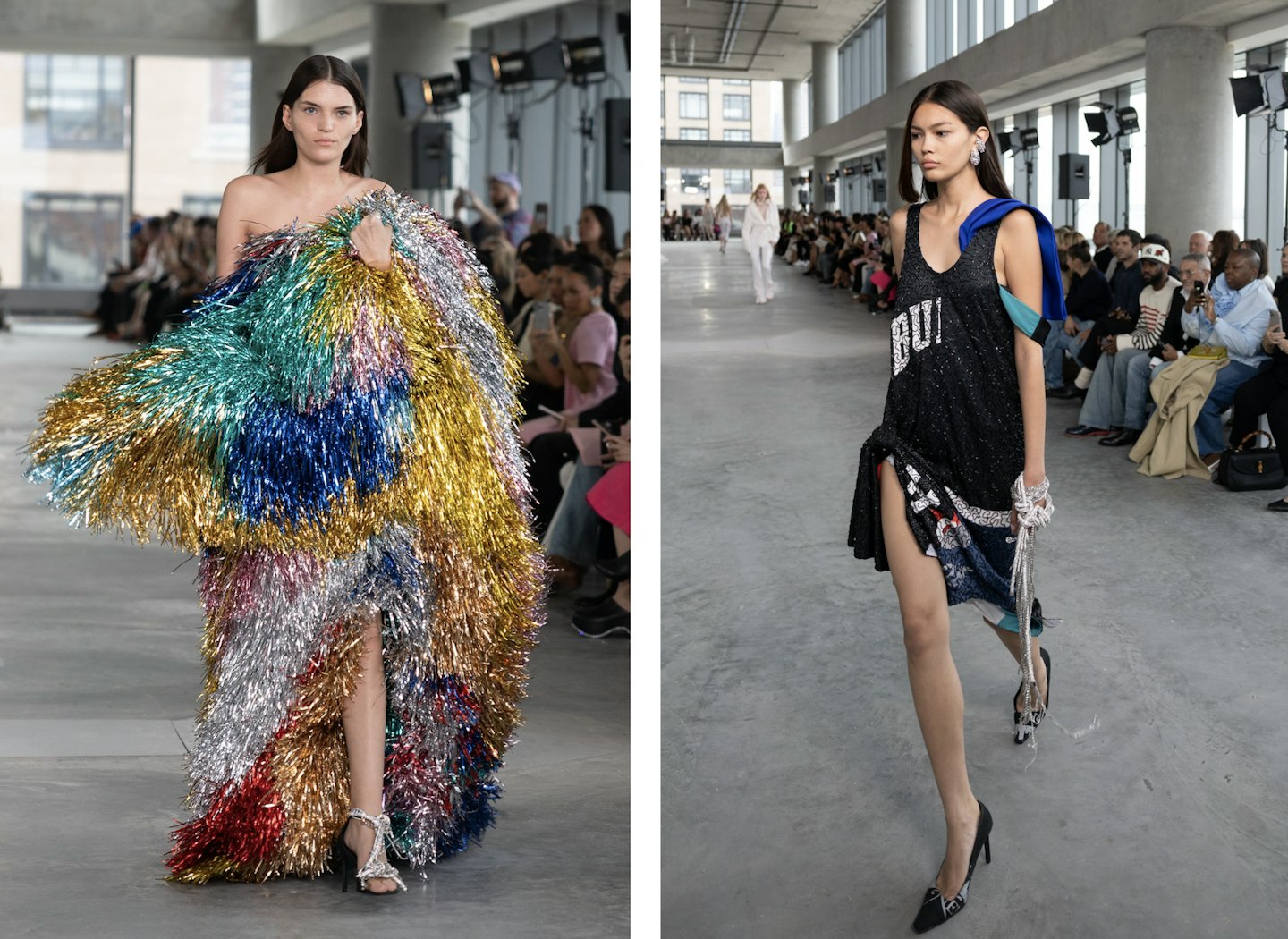
Nicholas Aburn’s debut for Area proved that New York is still capable of delivering fashion fireworks with intellect behind the sparkle. The Central Saint Martins alum and Balenciaga couture graduate leaned confidently into the brand’s DNA - crystals, sequins, micro-minis - while gently softening its once-hard edges. It started before the runway even lit up: the scratchcard invitation, a wink of theatre that set the tone for the playful irreverence to follow.
On the concrete runway, shimmer and spectacle reigned, but with a newfound discipline. Metallic gowns rippled like liquid foil, crystal-strung dresses flirted with fragility, and denim - yes, denim - was elevated into gowns and sweeping skirts that could coax even the most die-hard night owls into daylight. Basketball jerseys became glitzy slip-ons, pedal pushers were reborn, satin hoodies swung effortlessly alongside tuxedo-inspired skirts. It was Aburn’s deft balancing act: patchworked Americana colliding with showgirl exuberance (Taylor Swift, take note).
The finale, a rainbow tinsel explosion, embodied his thesis - fashion as mood-booster, as spectacle, as collective joy. Where his predecessor, Piotrek Panszczyk, made Area a downtown riot, Aburn seems poised to make it an uptown contender too, with craft and charisma stitched into every hem. Excitement fizzed in the room not just for the party-girl frocks, but for the rare alchemy of refinement and fun. A new era for Area has begun - and it sparkles even brighter than before.
Collina Strada
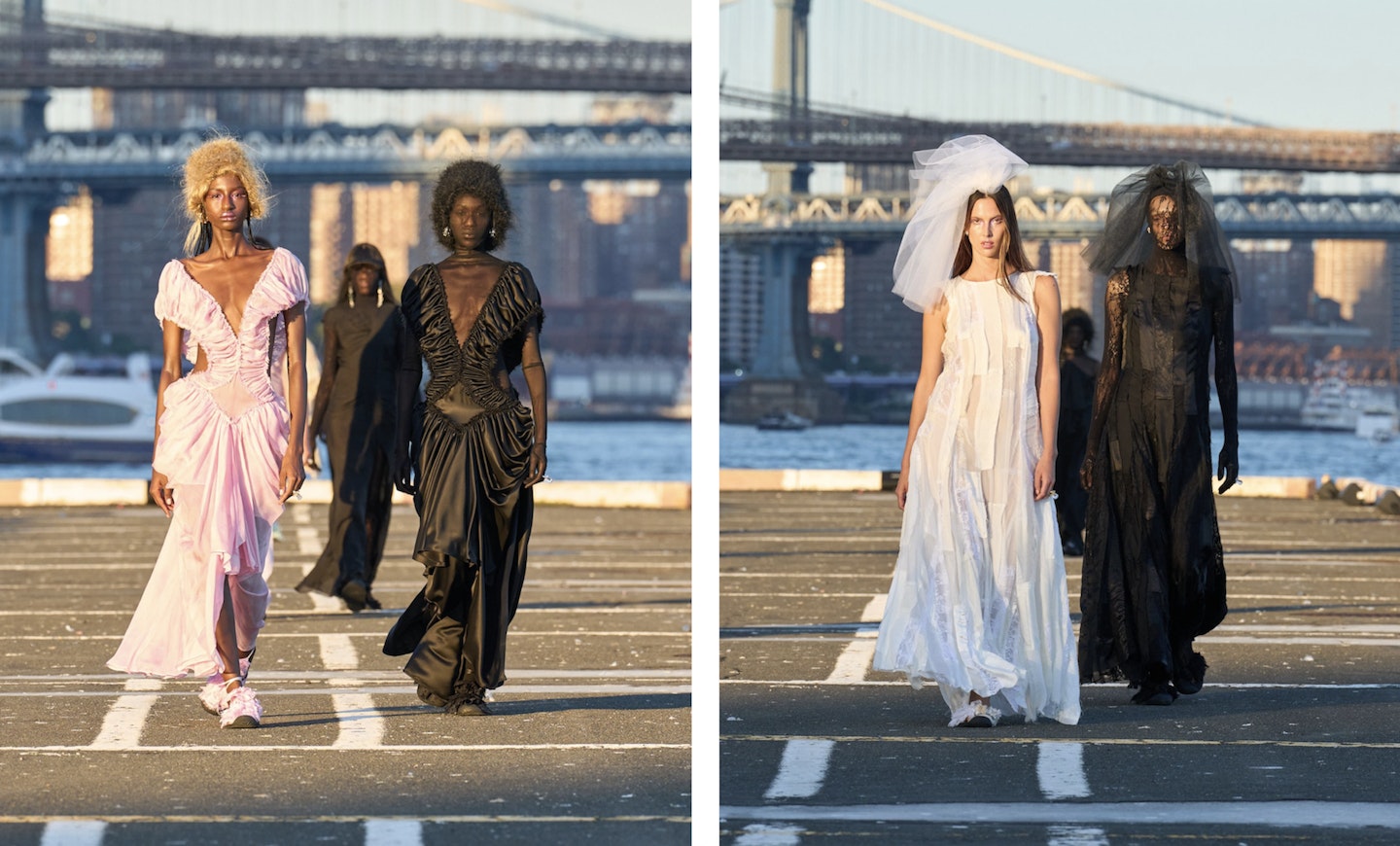
Collina Strada has never been afraid of a little drama, but for Spring/Summer ‘26 Hillary Taymour swapped her usual archaic chaos for something far more deliberate. At sunset on a helipad by the East River, the skyline provided a cinematic backdrop for a show that felt both conceptual and commercially astute. Known for her subversive club-kid energy, Taymour leaned into polish this season - the message clearer, the clothes sharper.
Seeing double? Yes, you did. Every look was shown twice: once in blush-tinted hues, often times soft as spun sugar, and once in black. A commentary on the policies, histories and systems that trail behind us, but also black also sells, as Michael Kors noted earlier this week, so the double act was as savvy as it was symbolic.
The 24-look collection, made 48 by its mirrored styling, read as a step-up. On the feet a Converse collaboration destined to sell out instantly. Above, a wardrobe that balanced whimsy with wearability: balloon trousers puffing with intent, denim reimagined, plaid co-ords cut clean, lace slip minis with mischievous edge. There was a peplum top that felt particularly dramatic, and a wedding dress (and its shadow twin in black) - it was all still Collina Strada (think playful, offbeat, defiantly conscious), but recalibrated for the next chapter. More mature, more measured, and ready to claim its place at the grown-up table.
Michael Kors
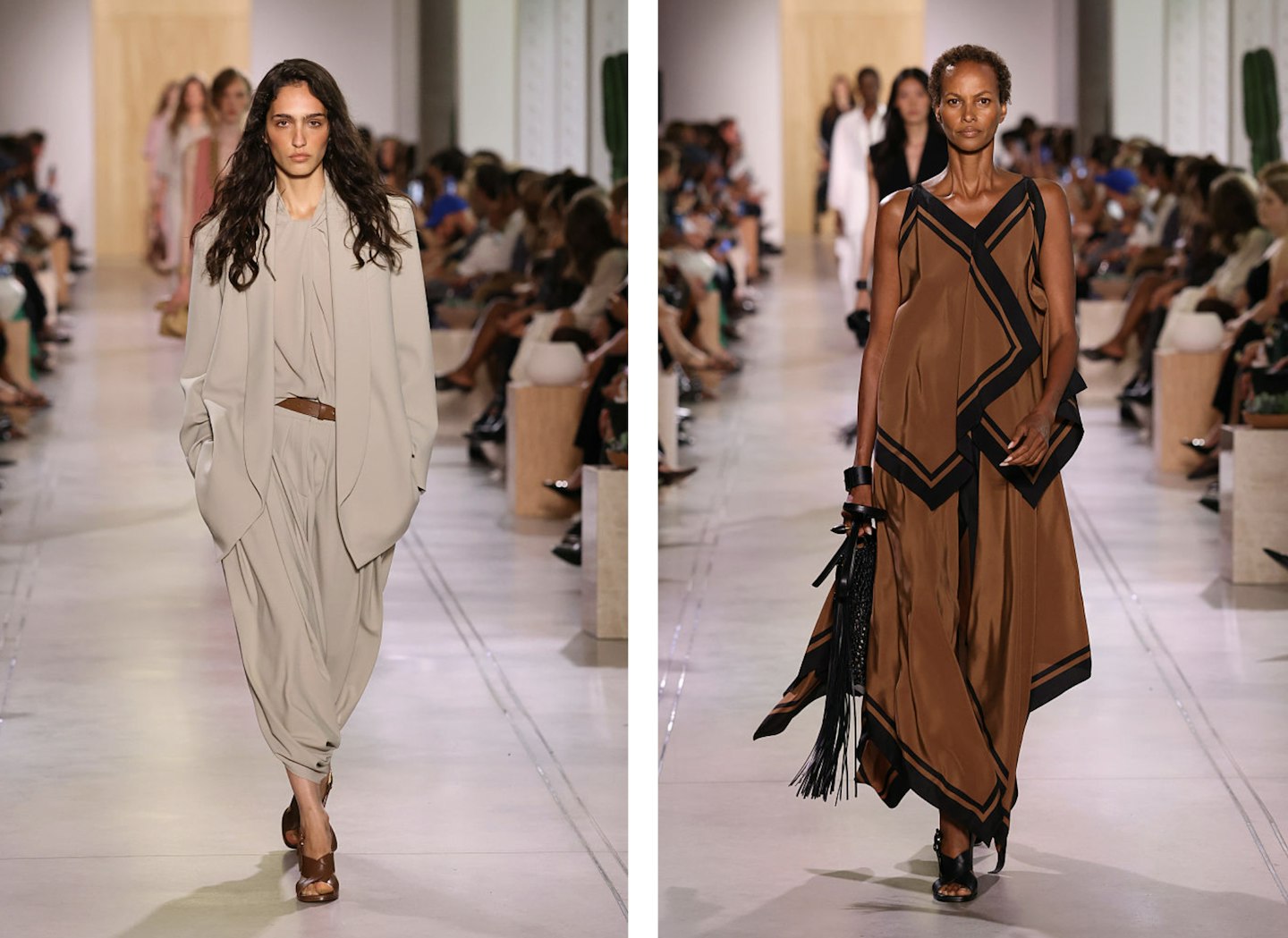
‘I think for any designer, the greatest thing in the world is not to be in a museum, it is to see people wearing what you designed and to know that you changed the way they get dressed,’ Michael Kors said at his Spring/Summer 2026 collection preview. ‘I mean, I bought my first Armani jacket. I saved up when I was 19 years old. I wore it to work. I wore it out dancing. I wore it on the weekends, and it felt modern and comfortable. He changed everything for tailoring, he influenced my whole life.’ That influence of the late Mr. Armani ran through Kors’s latest show, where soft tailoring appeared in even softer shades. But those jackets weren’t the only highlight. There were the literal stars - Gwyneth Paltrow, Leslie Bibb, Olivia Wilde - lining the front row, and the sartorial ones: draped culottes (constructed from a remarkable seven metres of fabric), bodysuit-and-skirt hybrids masquerading as dresses, and a generous dose of ‘veiling,’ Kors’s elevated, glamorous twist on the season’s taste for transparency.
Kors, a designer who has always styled himself as both forecaster and pragmatist, knows his clients because he listens to them directly. ‘People say 'Michael, you still go to the stores and talk to customers?' And I’m like 'Yes, of course, you’re stupid if you don’t talk to real people',’ he said. That pragmatism translates to the runway, too: no heels last season, no gowns this time. ‘In this entire show, there are no evening gowns, not one. I want to see people at night be able to have fun and to move.’ The palette echoed his travels with his husband - earthy neutrals, dusted pink, black, white, and grey - what he calls wardrobe staples, likening them to a pantry: ‘you need the essentials, and then you want some fun, you want to have some spice.’
The venue, a warehouse in New York’s West Village transformed to evoke his beach house, set the stage for an age-diverse cast, including women he first worked with more than two decades ago. ‘We have some models who I have not seen in over twenty years, which I think is wonderful. And if I do my job well, we should be dressing generations of people. I think that’s what’s so important.’
Ralph Lauren
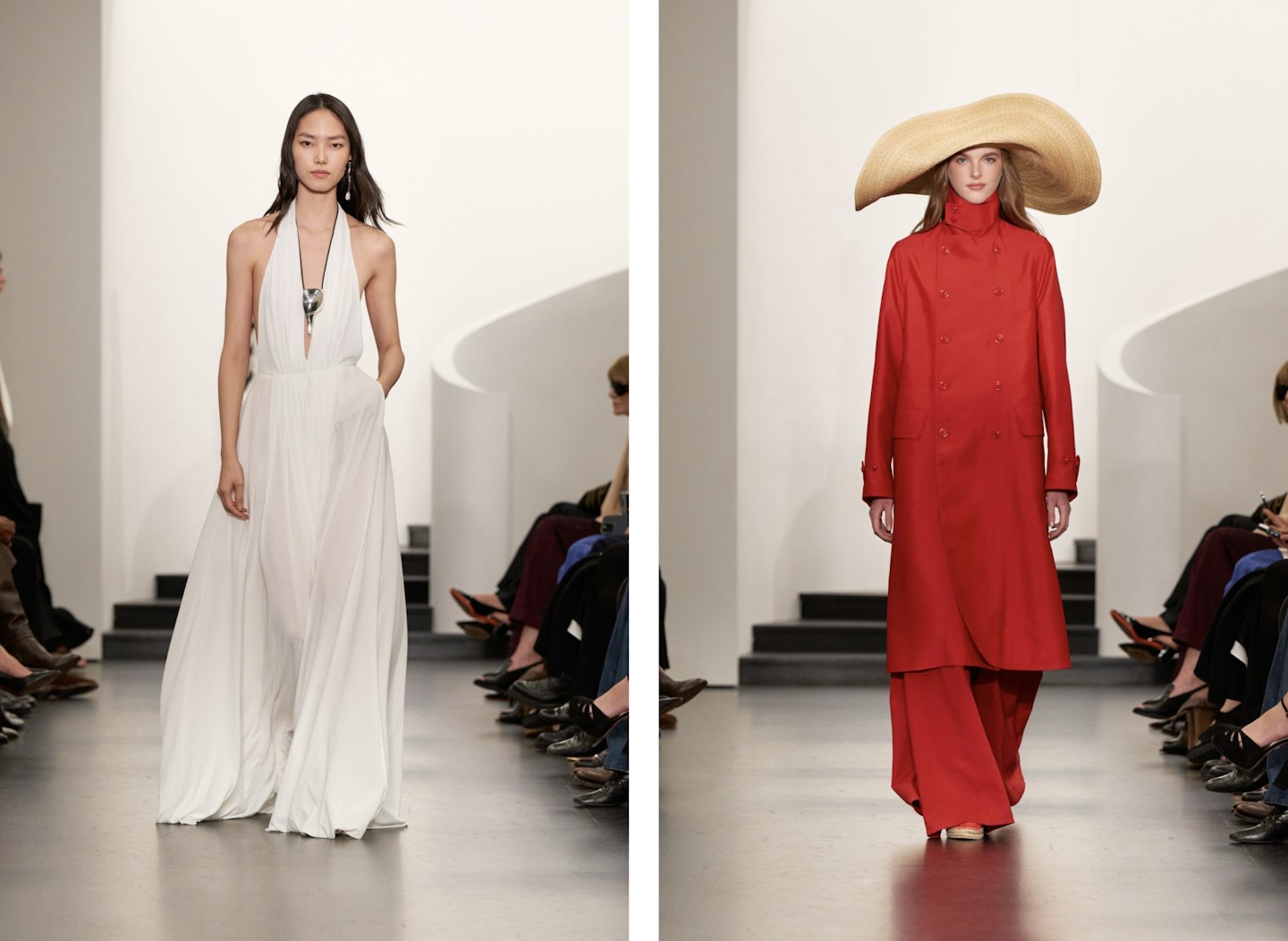
Ralph Lauren’s Spring/Summer 2026 presentation unfolded as a polished return to his Madison Avenue base, where plush seating and an intimate layout swapped fashion week’s usual austerity for quiet grandeur. Hollywood royalty - Laura Dern, Naomi Watts, Jessica Chastain - mingled with Oprah Winfrey and Gayle King, anchoring a front row that felt like an American cultural summit. Hours earlier, the Council of Fashion Designers of America, the industry’s preeminent awards body, had announced Lauren’s latest nomination for Womenswear Designer of the Year. The nod underscored his singular ability to stay relevant six decades in, and this collection reinforced why: it radiated a breezy sophistication, modern yet steeped in heritage.
The wardrobe was pitched perfectly for weekends in the Hamptons, with its crisp palette and unfussy refinement. Shell charms and silver pendants dangled like treasures picked up on the shoreline, wide straw hats shaded models with an air of casual elegance, and a bold red fisherman’s coat blazed across the otherwise pared-back set. Easy trousers with sarong-like wraps, bandeaus under tailoring, and slip dresses that slid into evening reinforced Lauren’s mastery of dualities - strength with softness, utility with allure. This was not an exercise in nostalgia but a reminder: when American glamour needs a benchmark, Ralph Lauren still sets it.
Proenza Schouler
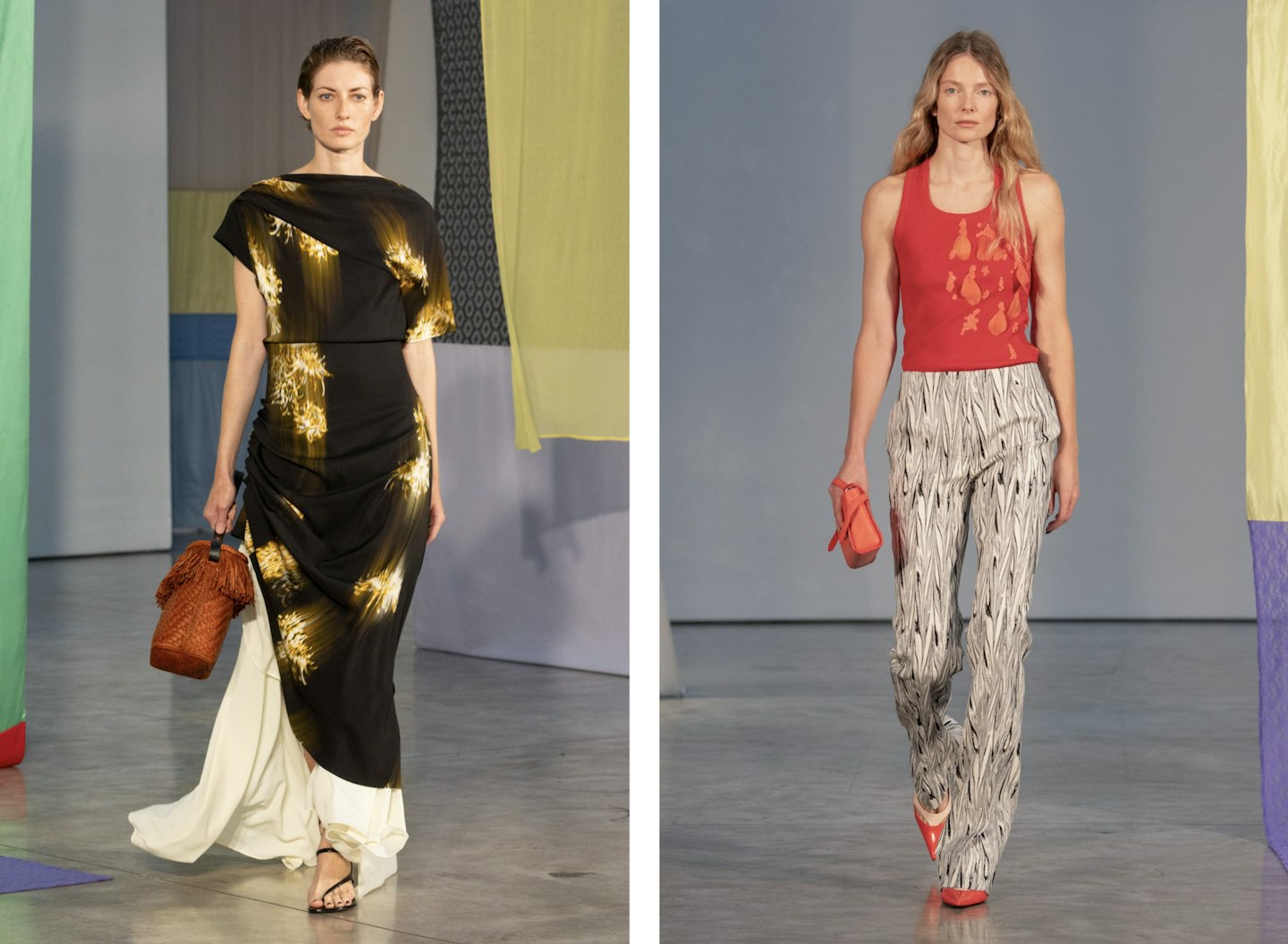
The carousel of new creative director debuts is in full swing this season, but all eyes landed on Rachel Scott - fresh from her CFDA Designer of the Year win, celebrated founder of Diotima, and now, the newly appointed creative lead at Proenza Schouler. Her debut wasn’t positioned as a grand arrival but rather as a prologue: the press release carefully framed it as a collaboration with the house’s atelier, a prelude to something more fully realised still to come. If this first outing is any indication, however, the brand best known for the cult PS1 bag is heading into an invigorating new era. Scott made it clear she’s pulling threads deliberately, unraveling the past to weave in her voice. As the show notes put it, 'evolution demands a soft undoing.'
That undoing came in subtle, clever gestures - shoulder pads that sat almost bare, hems edged with stray threads, blurred chrysanthemum prints scattered like watercolour stains. Creased fabrics, clashing surfaces, and sudden bursts of colour gave the collection a tactile, lived-in vibrancy. Dresses retained Proenza’s familiar architectural precision but carried Scott’s signature emphasis on craft. Accessories felt like punctuation: sheer organza boots blooming with flowers, appliquéd heels, striped bags of every size. It was a buoyant, celebratory moment - both the arrival of a female creative director at an American stalwart and a collection that teased what’s next. A double hurrah, and rightfully so.
Henrik Lischke is the senior fashion news & features editor at Grazia. Prior to that, he worked at British Vogue, and was junior fashion editor at The Sunday Times Style.
